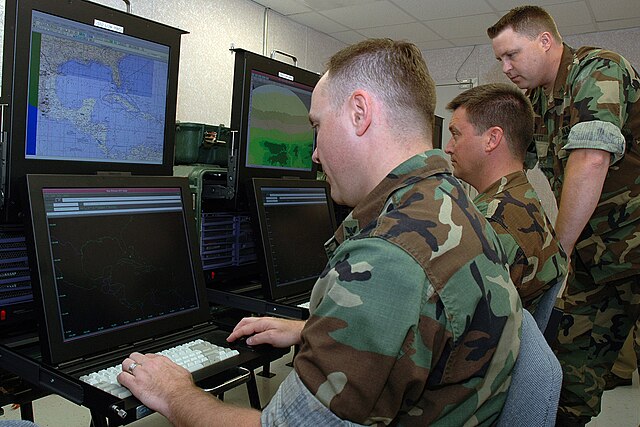Information Management Driving Decision Supremacy

Introduction
In today’s complex and fast-paced battlespace, the ability to make swift, informed decisions is often the difference between success and failure. Yet, many organizations, including those responsible for transatlantic defense interests, have lost their way regarding Information Management (IM). This allows this critical discipline to devolve into a mere support function—a service desk for troubleshooting computer issues—rather than the operational enabler it must be. This drift from its core purpose undermines IM’s potential to accelerate the decision cycle, leaving commanders without the timely, actionable information they need to maintain a strategic edge. Meanwhile, our adversaries recognize the power of information supremacy and rapidly advance their capabilities, potentially outpacing us in areas that matter most. We explore the organization, processes, and infrastructure necessary to reclaim IM as a warfighting advantage. This will reignite its role as a force multiplier driving operational success. The stakes are too high for complacency; it is time to act with urgency and purpose.
Background Context and Decision Supremacy
Historic commanders could count on military genius to effectively cut through Clausewitz’s Fog of War, forming a quick, intuitive understanding of the battlefield; however, modern commanders deal with operational problems of greater complexity and constant evolution. Undoubtedly, Napoleon Bonaparte and Gustavus Adolphus were military innovators, but their span of control and available data pale compared to Dwight Eisenhower or Georgy Zhukov.
Advocates of intuitive decision-making argue that senior leaders possess the experience to choose the right course without relying on data or structured analysis. Indeed, senior leaders are undoubtedly skilled; however, if they know more than their staff in every specialty, it signals a failure in staff development, not a testament to a leader’s brilliance. Leadership excellence isn’t innate, it’s built through systematic study, rigorous professional development, and exposure to structured decision-making processes. Leaders need a well-trained staff capable of synthesizing data into actionable recommendations. This will ensure decisions are made with clarity and speed.
Information as a Warfighting Enabler
At its core, the decision cycle—the process of gathering, analyzing, and converting information into actionable options—determines victory at every level of war. A commander who cycles through this process faster than the enemy gains a decisive edge. By assessing, adapting, and acting before the opponent has finished analyzing, a commander forces the adversary into a constant state of reaction, always struggling to catch up. This effect compounds in crises, where rapid decisions shape the battlespace in real-time.
Army doctrine emphasizes the disruptive power of a fast decision cycle, stating that a commander “can generate confusion and disorder and slow an adversary’s decision making.” This focus on tempo is not exclusive to Western militaries; China’s People’s Liberation Army is aggressively investing in artificial intelligence to accelerate battlefield decision-making. Yet, it must be noted that Russia’s failures in Ukraine highlight the dangers of valuing speed at the expense of precision. Agility matters, but effectiveness demands that decisions be not only fast but also sound.
While every military organization has its individual approach to the decision cycle, most follow similar principles. These frameworks are not far removed from those used by corporations and management consultants. The U.S. Army follows a cycle of Understand, Visualize, Describe, and Direct, : Observe, Orient, Decide, Act. Regardless of the terminology or origin, the goal remains the same: apply a structured method and ensure decisions are driven by well-analyzed information.
Understand the Decision Cycle
The OODA loop is a cornerstone of military decision-making, ensuring commanders act swiftly and accurately. Effective IM underpins this process, keeping decisions timely and well-informed. When IM falters—due to missing data, delays, or misinterpretation—the entire cycle risks collapse, leading to battlefield failure.
1. Observe
This phase gathers intelligence from surveillance, reconnaissance, and reports, with IM organizing data into a clear operational picture. A compromised Observe phase leaves commanders reliant on outdated or incomplete data, creating blind spots and flawed assumptions that weaken decision-making. Without robust observation, operations become reactive, forfeiting strategic advantage.
2. Orient
Raw data transforms into actionable intelligence, linking information to objectives and trends. Effective orientation identifies patterns and anticipates threats. Failures, whether from misinterpretation or information overload—lead to flawed assumptions and disjointed decisions. Without proper orientation, commanders risk confusion and paralysis.

3. Decide
Decision-making translates analysis into action, evaluating options based on intelligence. IM ensures clarity and accuracy, preventing rushed or flawed choices. Poor IM can delay decisions or lead to reckless actions, particularly in fluid environments where errors have immediate consequences.
4. Act
Execution depends on clear communication and real-time data access, with IM facilitating adjustments as conditions change. Weak IM in this phase disrupts coordination, slows responsiveness, and creates vulnerabilities. These issues cause delays that force reactive operations, compromising mission success.
Speed
A strong decision is only as valuable as its timing. The key is completing the cycle faster than the adversary, forcing them to restart and keeping them perpetually behind. A well-functioning OODA loop ensures strategic dominance by enabling proactive, decisive action before the opponent can react.
The cycle helps commanders act quickly and wisely, but balancing speed with depth is both an art and a science. Agility allows rapid adaptation, while depth enhances decision quality. An appropriate balance depends on the level of war, decision urgency, and risk tolerance.
At the tactical level, speed is critical—commanders must react fast to threats and opportunities. IM filters noise and delivers key data for swift action. At the operational level, coordination requires both speed and depth. IM consolidates diverse information into a cohesive picture, enabling broad assessments without losing momentum. At the strategic level, thoroughness is essential, as decisions shape campaigns. IM tools like or stochastic simulations, which provide decision-makers with probabilities of likely outcomes for a range of military operational or logistics problems, aid long-term planning, though adaptability remains vital.
Across all levels, effective IM turns raw data into actionable intelligence, keeping commanders ahead of adversaries.
Risk Tolerance and Decision Speed
Risk tolerance influences how fast decisions are made. Risk-tolerant commanders prioritize agility, acting with incomplete data. Here, IM must highlight only the most critical information to avoid delays. Risk-averse commanders, seeking certainty, rely on IM for detailed analysis, scenario modeling, and cross-checking. This is slower but more deliberate.
Strong knowledge management enforces a structured decision cycle, ensuring a reliable flow of vetted information. Systems that document and validate decision-making instill confidence, distinguishing well-developed recommendations from impulsive ideas. Without such systems, commanders may question whether a proposal is thoughtful analysis or mere speculation.
Historic Examples
Success, in retrospect, is often attributed to personalities and individuals rather than systems. People are far more willing to shift blame to a system when attempting to understand defeat. Napoleon’s 1812 Russian campaign and MacArthur’s 1951 forced retreat in Korea are well-studied failures in decision cycle dynamics. Some equally insightful but less studied include Lord Raglan’s Charge of the Light Brigade and Custer’s defeat at Little Bighorn which both exemplify failed IM processes within the commands.
Procurement failures lack the drama of battle, but their impact can be just as costly. We’ve all seen massive resources wasted on projects doomed from the start—failures that, in hindsight, were entirely predictable. Many stem from poorly defined requirements that proper analysis would have flagged. Even more concerning is when organizations, both within and outside government, allow contractors to define operational needs, creating a clear conflict of interest that prioritizes vendor agendas over mission success.
Three Pillars
Understanding the framework underlying a command’s IM needs, a commander must understand the organizations, processes, and infrastructure required to achieve efficient decision cycles in support of decision supremacy.
Organization
Modern organizations face a critical challenge: ensuring IM systems are run by experts, not unqualified personnel who reshape IM functions to fit their limited capabilities. Over time, these misalignments have transformed IM from a warfighting enabler into little more than a service desk, eroding its core mission. Look at any IM operation that spends the majority of its time validating email accounts or providing user training, and one can safely assume that they are not focused on decision superiority.
To reverse this trend, organizations must hire, train, and develop operationally minded IM professionals with the expertise to design systems that drive decision superiority. Accredited training and certification programs are essential to building a workforce capable of executing these high-stakes tasks. The significant breadth of programs under the IM (sometimes Knowledge Management) umbrella requires focused decisions on which approach an organization will pursue. Somewhat narrower in scope, existing military training programs lean toward the intelligence field, while the civilian training opportunities provide limitless options for specificity of approach. These programs must embed IM into operational planning, ensuring personnel can support fast, precise, and mission-critical decision-making in complex environments.
Beyond a skilled workforce, leadership is essential. Senior leaders must have the authority to enforce best practices and prevent drift toward inefficiency. They must protect the core mission, ensuring teams stay focused on operational priorities rather than being sidetracked by administrative tasks. By fostering a culture of accountability—where IM is a strategic enabler, not a back-office function—organizations can reclaim IM as a force multiplier, driving decision superiority and operational success.
Processes
Hiring and training lay the groundwork, but sustainable, long-term change requires policy reform to reshape organizational culture. A clear framework define roles, responsibilities, and objectives to align IM across divisions and vendors while accelerating the decision cycle.
IM professionals should drive decision superiority, designing systems that deliver fast, actionable intelligence. Policy must integrate IM into operational planning, while IT divisions focus on secure, scalable infrastructure that enables IM without dictating objectives. Vendors and contractors must be held accountable to strict requirements, ensuring they support, not influence, operational planning. Strong policies enforce accountability, prevent mission drift, and reclaim IM as a strategic advantage.
One of the key policy areas must always relate to the control of agreed-upon source data. Reliable data underpins every process, yet version control issues frequently disrupt workflows, slowing operations and creating uncertainty. In a data-driven environment, commanders must trust that information is accurate and singular—multiple versions breed confusion and operational chaos. While flexibility in decision-making is key, confidence in data integrity is non-negotiable. Beyond the battlefield, authoritative data also supports automation, allowing personnel to focus on complex problem-solving rather than routine tasks.
Policy must standardize IM best practices to ensure consistency, security, and efficiency. This includes strong data governance, adherence to decision-support protocols, and rigorous security standards. Regular audits and reviews maintain compliance, refine processes, and prevent drift. Embedding these standards into policy keeps IM aligned with operational priorities, responsive to emerging challenges, and fosters accountability.
With a strong policy foundation, IM evolves from a support function into a strategic force multiplier, fully integrated into the decision cycle. Clearly defined roles, disciplined requirement generation, and adherence to best practices ensure IM remains mission-focused, laying the groundwork for decision supremacy and operational success.
Infrastructure
With organization and policy in place, the next step is investing in infrastructure and technology to accelerate decision-making. IM provides tools that balance speed and depth, ensuring optimal decisions in any scenario.
Infrastructure decisions must separate requirements generation from service provision to prevent conflicts of interest. IM needs should be defined internally by operational personnel focused on efficiency and interoperability. Allowing vendors to dictate requirements leads to fragmented, inefficient systems. Organization-driven requirements ensure alignment with strategic objectives, fostering integration and reducing redundancy.
A major challenge is the shortage of professionals who can translate operational needs into effective architecture. Too often, IM leadership is filled by IT technicians who defer requirements to external providers, leading to reactive, disjointed solutions. While “innovation cells” attempt to compensate for weak IM leadership, they are temporary fixes that degrade long-term IM expertise. Without skilled professionals bridging operations and technology, decision superiority remains out of reach.
Infrastructure categories include IM systems that enhance decision speed by filtering and prioritizing data, ensuring commanders receive only high-impact information. Dashboards for real-time operational snapshots, consolidate key metrics for rapid situational awareness. For deeper analysis, scenario modeling and predictive analytics simulate potential outcomes, aiding risk assessment and long-term planning. Automated reporting systems eliminate manual updates, delivering critical information on schedule or on demand. By aligning with the battle rhythm, they enable faster responses to evolving conditions.
Commercial Solutions
Industries beyond the military are revolutionizing IM with tools that transform raw data into real-time, actionable insights. AI-driven platforms like Palantir and Splunk process massive datasets at high speed, using machine learning to detect patterns, predict trends, and flag anomalies for decision-makers. Collaborative data ecosystems such as Microsoft Azure Synapse and Google Cloud’s BigQuery integrate disparate sources into a single, accessible platform, streamlining cross-functional data sharing and ensuring personnel work from a unified source of truth. Imagine a command environment where maps, intelligence reports, and logistics updates are instantly available without navigating multiple systems.
However, tools are only as effective as the systems supporting them. The military’s long history of structured decision-making provides a wealth of policies and procedures to guide IM. Yet, the true challenge lies in discipline—following each step rigorously. Too often, organizations bypass inconvenient steps, justifying shortcuts under crisis, pressure, or time constraints. Without structured adherence to processes, even the most advanced technology cannot guarantee superior decision-making.
While we recognize that there are times when commanders must make snap judgments, we find that most of the time, the decision is not so urgent that an accelerated cycle could not be implemented. The best organizations enforce high levels of discipline without creating information delays or bottlenecks.
Call to Action
Modern warfare is not won by firepower alone—it is won by those who out smart, out decide, and out maneuver the adversary in the information space. Yet, our systems lag, burdened by outdated processes, while adversaries move decisively. China’s AI-driven systems accelerate battlefield agility, threatening to surpass the West. Russia’s actions in Crimea and Ukraine were wake-up calls. We cannot wait for another crisis. The time to act is now.
Imagine a battlefield where intelligence, logistics, and operations data flow seamlessly, free from email chains and PowerPoint slides. This is not a distant vision; it is a necessity. Victory depends on IM systems that cut through noise, prioritize critical data, and deliver real-time intelligence. Automation, predictive analytics, dynamic dashboards, and real-time collaboration already exist. What’s missing is the urgency to adopt them and the discipline to implement them effectively.
The stakes have never been higher. Inaction means slower decisions, allowing adversaries to exploit our weaknesses. But this is not inevitable. By treating IM as a warfighting advantage, building a mission-driven IM workforce, and embracing cutting-edge tools, we can seize the initiative and redefine how we fight.
Incremental change is no longer enough. Lead the way. Demand more from IM teams, commanders, and yourself. The West’s dominance depends on it. Decision supremacy must remain ours—not just today, but for every battle ahead.
(Disclaimer: The views in this article are those of the authors and do not necessarily reflect those of NATO or The US Navy and all opinions are our own. None of the discussion should be taken as an official endorsement by NATO or the U.S. Navy of the products and services mentioned.)









I do not think we can overestimate the importance of this issue.
My recommendation is to adjust the five paragraph operations order and special paragraph 5: command and signal. I think we have lost the art of determining not just what information commanders need but what are the actual discussions the commander must make as well as subordinate commanders. The result of the COA development and wargaming and COA selection would also include an analysis of the key decision a commander must make as well as what decision are delegated to subordinate commanders. Before you can identity the information required for decisions you must identify the decision that need to be made. Although it seems obvious what are those decision, I would posit the commander has to make too many decisions and if you can identify the key decisions he must make (and this the information necessary to support those decisions) you can provide the commander (and subordinate commanders) more opportunity to exercise “‘Fingerspitzengefühl ‘in command and control that emphasizes an intuitive grasp of the situation and the ability to respond appropriately and tactfully. It goes beyond the literal translation of “fingertip feeling” to describe a deep situational awareness and the skill to react effectively to evolving circumstances” while they are operating on mission and intent (Auftragstaktik or Mission Command). Identifying critical command decisions must be a central focus of the staff and in parallel it should also be looking to reduce the number critical decisions the commander must make. This could have the added benefit of reducing micromanagement as well as demanding only the necessary information for decision making from subordinate units thus reducing information overload (too often we operate our information processes on the concept of more is better nad I will know what I want/need when I see it).
My bottom line is that we should add a supporting sub-paragraph to Paragraph 5 that identifies critical Command decisions at appropriate command levels. Then we can employ effective information management processes to support those decisions.